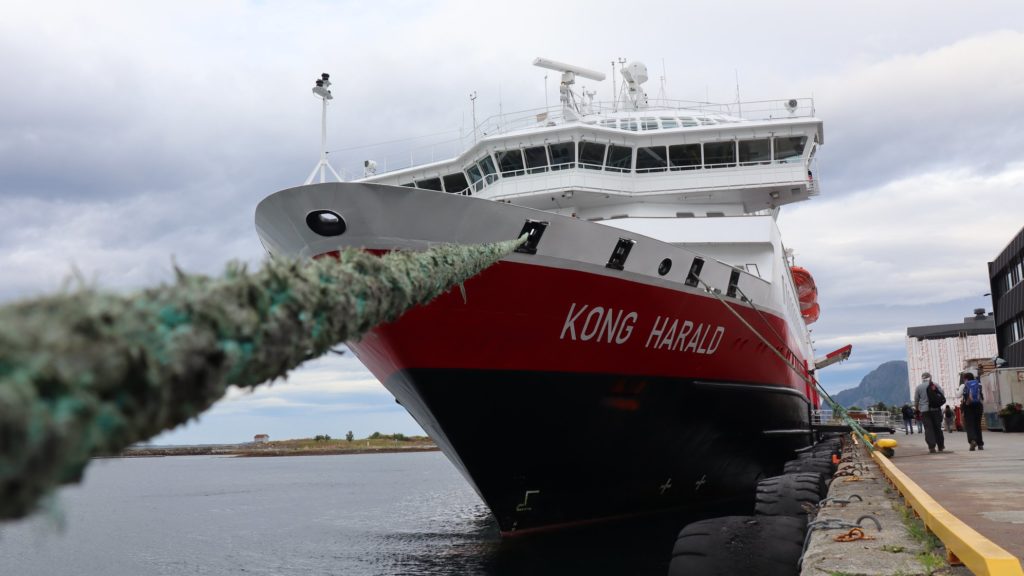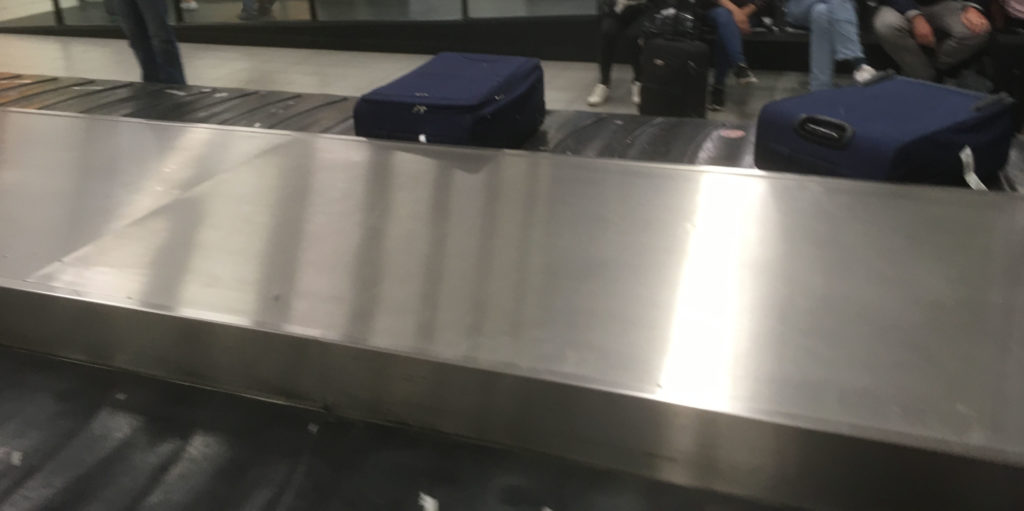So I got myself a couple of these new Apple AirTags. They allow you to keep track of your keys, your bike, your car, etc. The “FindMy” app allows you to see where they are…but that is where it stops.
Wouldn’t it be cool if you had an app that could not just show you where your airtag is, but also where it’s been? You could send the tag around the world and keep track of it, see which spots it has been on, with proper map integration. And maybe even allow for communication to whoever finds/gets the AirTag so that it can be sent back (with proper reimbursement), or sent to the next address on its path? Or that the tag owner would get notifications when a specific spot is “visited” (like the same city as the Taj Mahal, or the continent of Antarctica, or near the Great Wall of China, or basically any other set of locations worthwhile according to what the user wants).
I don’t know the exact protocol used with these AirTags. I do think there is some sort of possibility of communication with the finder (at least a notification, which may or may not have standard text). And it’s obvious there is always some chance of losing the tag. But I feel this is an app idea worth investing some brainstorm time in…and then for it to be concocted by someone who can actually make iPhone apps 😉
Category Archives: internet
DNA & Genealogy
In June 2016 I decided to partake in the Genographic Project, which was where National Geographic organised a global, affordable and appealing way to have your DNA analysed, to give insight into your ethnic background. Ostensibly, it was set up to show people how we’re all much more related than you’d think (perhaps most shockingy for those who consider themselves of a pure race). All you had to do was collect some saliva and mail it off to be processed, after which you’d find out where you fit on the huge patchwork quilt of human ethnicity.
My urge was mostly triggered by regular curiosity, but also because one of my grandparents (my late mother’s father) is unknown. My maternal grandma had been, let’s so, fruitful with several partners before she got legitimately married. My mother used to say her biological father was probably a German soldier (her having been conceived in World War II), but there was no telling whether that was actually true. She had distanced herself from that past, at any rate, by legally changing her surname from her biological mother’s to her adopting family’s the moment she became of age.
I had always known about these circumstances, roughly, except for the actual dates and later marriage, which my dad found out about when he did family tree research around the turn of the century. In fact, my mother turned out to have had two half-siblings from before her mother’s marriage, plus two more that were conceived in wedlock. Except for one of her pre-marital half-siblings, whom I had known as an uncle, I did (and do) not know where the others (who happen to be aunts) live. My dad said that my maternal grandma’s pre-marriage history was also unknown (and, indeed, upon my dad revealing it, initially denied) by her grandchildren.
Anyway, back to the ethnicities revealed by my DNA results, which I received after a few months:
55% Scandinavia
20% Southern Europe
12% Western and Central Europe
7% Great Britain and Ireland
6% Eastern Europe
1.1% Neanderthal
Because I had primarily known about my family being from the Dutch province of North Brabant (granted, that’s mostly from the Karsmakers side), I was a bit surprised by the analysis. Had my mother’s genes instilled a lot of Scandinavian heritage? I didn’t know. I also didn’t really know how to interpret the results, so my initial enthusiasm petered away. I got back to my daily life and didn’t heed the DNA stuff much. Somewhere in 2019, National Geographics discontinued their Genographic Project, too.
Early this year I stumbled onto another site, 23andme.com, where you could order DNA collection kits as well. More or less on a whim, I ordered three (one to use for myself as a re-start, one for my wife, and one for her son – my stepson). By the end of March I received the results again. They were a little different, and perhaps more logical considering the German soldier anecdote:
85,6% French & German (which for some reason includes Belgium and the Netherlands)
12,3% Great Britain and Ireland
0,5% Scandinavian
1,6% broadly Northwestern Europe
<2% Neanderthal
Part of the results on 23andme.com also showed so-called “DNA Relatives”, i.e. people with whom you have a certain part of your genetic material in common. The closest turned out to be a 3rd cousin, which is a person with whom I very likely have 2nd great-grandparents in common (see picture).
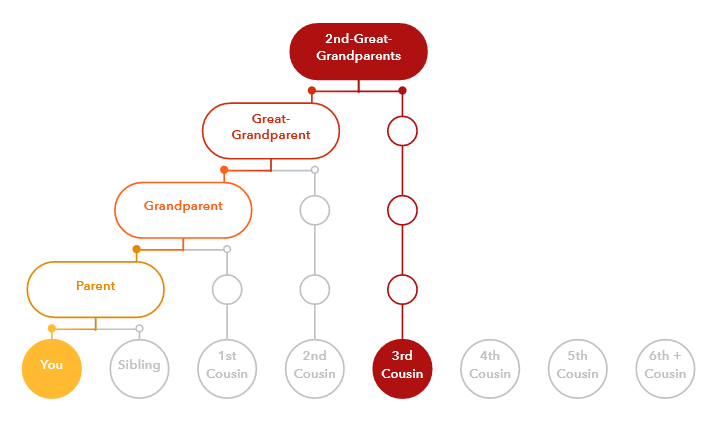 Someone on 23andme.com advised me to check out a pretty good site to build your family tree, ancestry.com. I started converting some of my father’s family tree research (for which he had used a powerful but not very visual Dutch program called Aldfaer). This was rather a lot of work, initially, especially because I discovered that his research had been woefully Karsmakers-name-centric and unfortunately riddled with typos and even wrongly typed dates. After having added one or two generations to my family tree on the site, though, I noticed that ancestry.com started giving me Ancestry Hints, which are suggestions on who might be related to a person you have already added to your family tree. The algorithm is quite reliable, as it retrieves information from their vast database that has (parts of) names and specific dates in common with people in your tree. They take this information from a large variety of reputable (indeed, often official) online genealogical sources, as well as other ancestry.com member family trees. In fact, their database is so enormous that you end up with more hints than you have time to handle (to wit, my current tree has 2363 people with nearly 5000 of these hints I should still check out). And every person you add gives you more new hints.
Someone on 23andme.com advised me to check out a pretty good site to build your family tree, ancestry.com. I started converting some of my father’s family tree research (for which he had used a powerful but not very visual Dutch program called Aldfaer). This was rather a lot of work, initially, especially because I discovered that his research had been woefully Karsmakers-name-centric and unfortunately riddled with typos and even wrongly typed dates. After having added one or two generations to my family tree on the site, though, I noticed that ancestry.com started giving me Ancestry Hints, which are suggestions on who might be related to a person you have already added to your family tree. The algorithm is quite reliable, as it retrieves information from their vast database that has (parts of) names and specific dates in common with people in your tree. They take this information from a large variety of reputable (indeed, often official) online genealogical sources, as well as other ancestry.com member family trees. In fact, their database is so enormous that you end up with more hints than you have time to handle (to wit, my current tree has 2363 people with nearly 5000 of these hints I should still check out). And every person you add gives you more new hints.
To give you an indication on how user-friendly ancestry.com is: I started on April 13 and today, May 8, I have added the abovementioned number of people, and managed to find all my direct ancestors that ancestry.com knew about.
Like I explained above, I only know 3 of my grandparents. This means I have 6 potentially known great-grandparents, 12 2nd great-grandparents, 24 3rd great-grandparents, 48 4th great-grandparents, and so on and so forth. Using the ancestry.com site, I even managed to find 8 (of my possible 98,304 😉 15th great-grandparents, dating back to the second half of the 15th century. I found all potentially known 12 2nd great-grandparents, which provided me with the information I needed to contact that 3rd cousin I found on 23andme.com.
A total of 2 parents (50% DNA in common) were found of a possible maximum of 2 (100%)
A total of 3 grandparents (25% DNA in common) were found of a possible maximum of 3 (100%)
A total of 6 great-grandparents (12,5% DNA in common) were found of a possible maximum of 6 (100%)
A total of 12 2nd great-grandparents (6,25% DNA in common) were found of a possible maximum of 12 (100%)
A total of 20 3rd great-grandparents (3,13% DNA in common) were found of a possible maximum of 24 (83%)
A total of 29 4th great-grandparents (1,56% DNA in common) were found of a possible maximum of 48 (60%)
A total of 50 5th great-grandparents (0,78% DNA in common) were found of a possible maximum of 96 (52%)
A total of 71 6th great-grandparents (0,39% DNA in common) were found of a possible maximum of 192 (37%)
A total of 89 7th great-grandparents (0,20% DNA in common) were found of a possible maximum of 384 (23%)
A total of 88 8th great-grandparents (0,10% DNA in common) were found of a possible maximum of 768 (11.5%)
A total of 69 9th great-grandparents (0,05% DNA in common) were found of a possible maximum of 1536 (4.5%)
A total of 64 10th great-grandparents (0,02% DNA in common) were found of a possible maximum of 3072 (2%)
A total of 58 11th great-grandparents (0,01% DNA in common) were found of a possible maximum of 6144 (1%)
A total of 54 12th great-grandparents were found of a possible maximum of 12288 (0.44%)
A total of 43 13th great-grandparents were found of a possible maximum of 24576 (0.17%)
A total of 30 14th great-grandparents were found of a possible maximum of 49152 (0.06%)
A total of 8 15th great-grandparents were found of a possible maximum of 98304 (0.01%)
Except for these arguably sterile statistics, ancestry.com also allows you to unearth information of a non-genealogical type. I found out, for example, that one of my granduncles was put to work in Germany during World War II (because ancestry.com has access to the files the Germans kept about these things), and that several of my more distant ancestors (10th great-grandparents and up) are from Belgium, Denmark or, indeed, Norway. I have the feeling that I am only just at the beginning of this road of discovery!
For those of you who have reason to find out whether they are related to me (and, if so, from whom exactly), here’s the Excel file with my direct ancestors as far as I know them: Direct Ancestors.
For those who want to actually compare their DNA with other people’s, or have it analysed in a variety of ways, you can upload your raw DNA data to Gedmatch (if you want to compare it to mine, my kit number is UY9604721). The Gedmatch site will accept raw DNA data exports from 23andme.com as well as other popular DNA analysis providers. It will also allow you to do much more DNA-related exploration that has so far turned out to be too complicated for me to explore.
The ancestry.com site also offers their own DNA analysis kit, but they unfortunately do not allow for raw third-party DNA data to be imported. Also, in case you want access to their whole Ancestry Hints database when building your family tree, you need to pay a fee.
Announcement of new Fear of God / Détente site with Forum
At the time I discovered Kevin’s tribute site, he barely did anything to update it anymore. So when I asked him if I could take over, I think he happily agreed.
So on 8 December 1998 I launched the first iteration of my version of the site. Since I was not in touch with any members of the original line-up, it focused on the then current incarnation of the band, going by the name of Fog. My main contacts were vocalist John Childs and guitarist Tony Mallory. The domain was jezabelsdreams.com, named after the album released by this band.
Years later, I happened upon Tony Keastead’s Dawn Crosby fan page on Facebook. We struck up a mutually beneficial exchange of information. When I decided my Fear of God site wasn’t really going anywhere due to lack of time and lack of news, I contacted Tony to ask if he was willing to take it over and become the third webmaster. He agreed, and nearly 17 years to the day after I had re-started the site, he took over. I occasionally visited the site, and was glad to see it was being updated more often than I did.
During the Corona crisis it occurred to me that I should at least make sure that there was some semblance of a repository of All Things Dawn. This culminated in my registering fearofgod.band (fearofgod.com, my first choice, was taken by some fashion brand). I re-instated the site from a backup, checked out the Wayback Engine Internet Archive to add some of Tony’s latest changes, updated various bits and bobs on the site, and also added a forum.
Now it needs to be said: The new version of the site doesn’t use state-of-the-art web design techniques, so it may not work well on phones or other small screens. But there is for now, and the foreseeable future, a place where fans of Dawn and her bands can find information and, due to this forum, meet.
An idea for a cool smartphone App – developers please check out
I don’t know if such an app exists, or if it is already part of the functionality of an existing app, however…
The basic premise is that the app gives you a notification when you hit a certain GPS location. This can be used by yourself or by others. If you want to send a notification to yourself, it uses no external app. If you want to send a notification to others, it uses Whatsapp.
Some of the uses could be:
- Once you arrive at location you need a notification (when I am near the local supermarket, “I need to go in and get potatoes”)
- Once another person arrives at a location they wll get a notification (“good luck with your job application interview!”)
- When you arrive back home (“hang up the washing”, “get the food out of the freezer”)
- When someone arrives at their holiday destination (“Have a great holiday, don’t forget to use sun tan lotion” – or something less patronising 🙂
The ‘internal’ (notifications to yourself) received notification screen should have a button for “Close/OK” and a button for “Next time” (so it will give you the message again the next time you hit the same GPS location).
The notification creation screen should have a zoomable, scrollable map on which you can drop a pin, specify an optional user from your contacts list (with name and phone number(s) listed, and if no user is specified, it will notify the person themselves), and type the actual notification message.
How to cause a message to pop up on another person’s screen depending on their GPS location? I don’t know, Although it would make the app less userfriendly and less instantly usable, it might actually require the recipient to also have the app installed (which will probably require some sort of registration system – if so then based on their international phone number?). Or maybe this could be limited only to the people you also have in “Find My” (which on iOS allows you to keep track of where people are). This latter option would greatly limit the app’s use, as you might want to send people notifications that you’re not so close with that they have allowed you to follow their whereabouts.
I don’t know if Whatsapp supports fully automated sending of messages, but I do know Whatsapp is usable by other apps so in the worst case it could automatically trigger Whatsapp with a predefined addressee and message, waiting for the user to actually confirm sending it manually.
Should anyone pick up his idea, I ask to be involved in the development and testing process. Thanks!
ST NEWS Volume 12 Issue 1 – the 42nd Anniversary Edition
This morning I woke up with an idea. The idea was triggered largely by dreams I’ve had the past 20 years, off and on, where I was about to release the next issue of ST NEWS disk magazine (see here). Normally this would result in me waking up with a vague feeling of dread, as the pressure of finishing such an issue was never quite only a totally positive sensation. But this morning it was different. This morning, Sunday 6 October 2019, I woke up with a feeling of enthusiasm and anticipation. So I would hereby like to announce the release of the 42nd Anniversary issue, to be taking place on 26 July 2028!
I certainly don’t shun long-term projects, do I? Yes, it’s quite a few years in the future, but I have so many ideas that a) I think it will be worth the wait, and b) it will need a few years to arrange everything I’ve got planned. I intend for it to be the most ambitious undertaking since 1989’s “LateST NEWS Quest”, where Stefan and me visited just about everyone in England worth their ST-salt!
Some of the ideas are…
- interviews with key players of the former and current Atari ST scene
- features on hardware and software Atari emulation
- a type of “where are they now?” feature with as many previous co-conspirators and foreign distributors as possible
- a new ST-style demo in CODEF
- a new version of the Atari ST version of “The Final Grandson of Wowbagger the Infinitely Prolonged”, the first since August 1995’s version 4.242
- in memoriams of the people the game/ST scene has lost
- an updated Ultimate ST NEWS Reference Guide
- interview with Polly Jane Rocket Adams, Douglas Adams’ daughter
- all of if written using the authentic “1st Word Plus”
- it might be released as an Atari ST executable next to the st-news.com page version
If you have any other ideas, do feel free to share them with me and make this a truly memorable issue!
Hurtigruten – an Expected Journey (a.k.a. Norway Quest III)
Whenever you see a 3D Youtube video, you can swipe the video to view the scenery all around. Alternatively you can use the “View on Youtube” button and even watch the video using a VR headset or using a gyro-equipped smartphone.
Monday, 12 August.
Woke up after not having slept well. The bad sleep was probably caused by the anticipation of going on a trip, and not just any trip! Hurtigruten! My wife Ruth and I took just about the first train after 09:00 towards Schiphol airport.
We arrived well in time for Norwegian Airlines flight DY1257, 13:40-15:25 to Oslo. It made me think of the explosive scene in Douglas Adams’ “The Long Dark Teatime of the Soul”:
“The explosion was now officially designated an ‘Act of God’.
But, thought Dirk, what god? And why?
What god would be hanging around Terminal Two of Heathrow Airport trying to catch the 15:37 flight to Oslo?”
Oddly disappointingly, there was no explosion before we managed to board the plane well in time for it to depart well over fifteen minutes late. No explosion, obviously, of course, as it hadn’t been Heathrow, nor even a 15:37 flight. But such is the impression a beloved author can leave on a reader.
We landed at Gardermoen Airport, as opposed to Fornebu, the former airport where ST NEWS co-conspirator Stefan Posthuma and myself had made landfall in December 1989 at the start of what we had grandiosely called “The ST NEWS Norway Quest”.
Lots of things had changed since 1989. Luggage retrieval took mere minutes, which is quite unusual. Oslo Airport is the epitome of modernity, and even two such utter Norwegian-language-n00bs such as ourselves had little trouble finding the Airport Express train in the direction of Drammen (a word which in Dutch is the verb “to nag”, but nothing like the funny false friends we’d read on our way back home!). After the initial shock of the price of the train tickets (425 NOK = nearly 46 Euros) for two half-hour-travel tickets we took the 16:10 towards Drammen. At 16:42 we met Ronny Hatlemark (a.k.a. Ynnor the Divine One from the Days of Yesteryear) at Sandvika station. Ronny had barely changed since the last time I’d seen him during a brief visit of his to Utrecht in May 1998, with Torbjørn “Lord HackBear” Ose. His big smile was but the start of a continuous barrage of hospitality we were to enjoy until we left its warm embrace the day after.
Ronny drove us to what he would no doubt call a “humble abode” but which was really quite a sumptuous dwelling lying against a hill (in the Netherlands no doubt dubbed “a mountain”). We were met by the lovely Ginny and their Australian Cobberdog Walt (named after Whitman, not Disney). After a chat we were treated to a great three-course meal, at the start of which we found out that Ginny was rather a fan of cooking – and Ronny rather a lucky man.
During the meal and the ensuing evening we spoke of politics, language, adults being children with filters, Norwegians being cold cucumbers (or not), the erstwhile Atari ST scene, the current ST scene, education, and a variety of other subjects. Quite a difference from back in 1989, when conversations had centred around hacking, car dating, freezing cold weather, Papillons and stiff water.
Tuesday, 12 August.
During the night I entered the vicious circle of a headache causing non-perfect sleep (for the second night in a row), which in turn caused more of a headache. Thankfully the Hatlemarks were able to supply me with a couple of painkillers that twisted the vile headache’s neck. It was not to re-appear.
Breakfast was no disappointment either, including a re-introduction to (a probably milder version of) Norway’s Brunost (a fairly more pungent and darker version of which Stefan and me had been introduced to nearly 30 years earlier). Ronny and Ginny had prepared a map of Oslo with some places to be and things to do, so we had our day cut out for us.
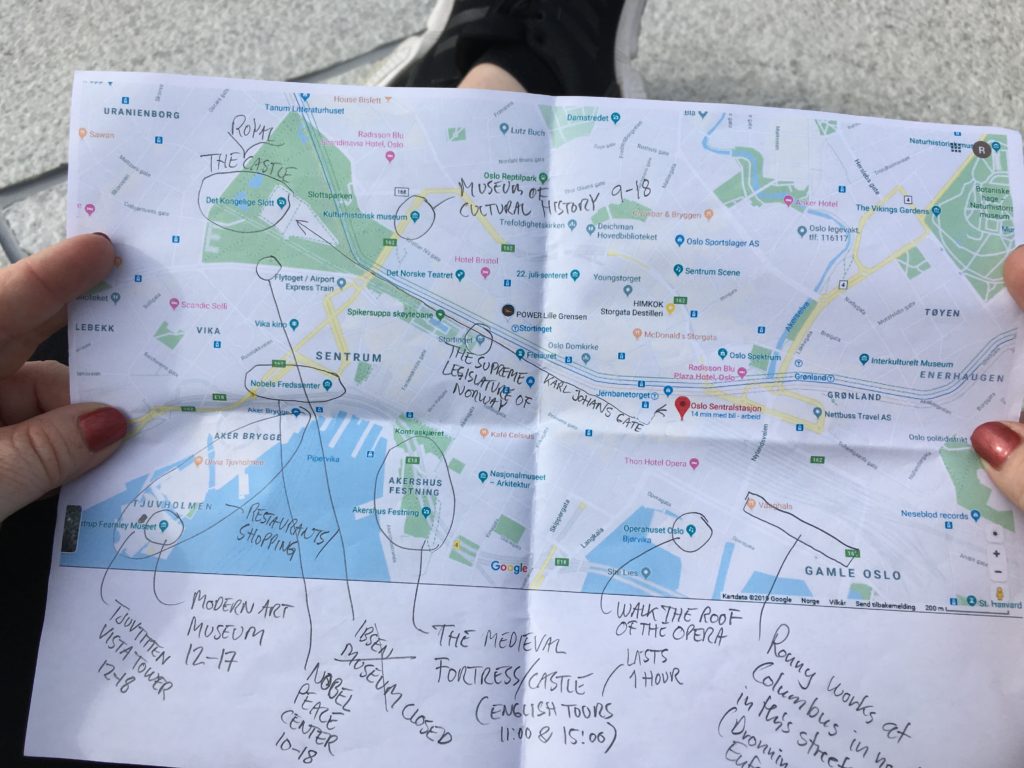 The morning inevitably led to a situation where, like the Great Bard was wont to write, any many others have since copied, parting was such sweet sorrow. After bidding adieu to Ginny and a tail-wagging Walt, Ronny dropped us off at the nearest Metro station. Our ways parted once more.
The morning inevitably led to a situation where, like the Great Bard was wont to write, any many others have since copied, parting was such sweet sorrow. After bidding adieu to Ginny and a tail-wagging Walt, Ronny dropped us off at the nearest Metro station. Our ways parted once more.
Ronny. Awesome dude. Old friend. Fine host. And Ginny is cut from the same cloth – a wonderful couple.
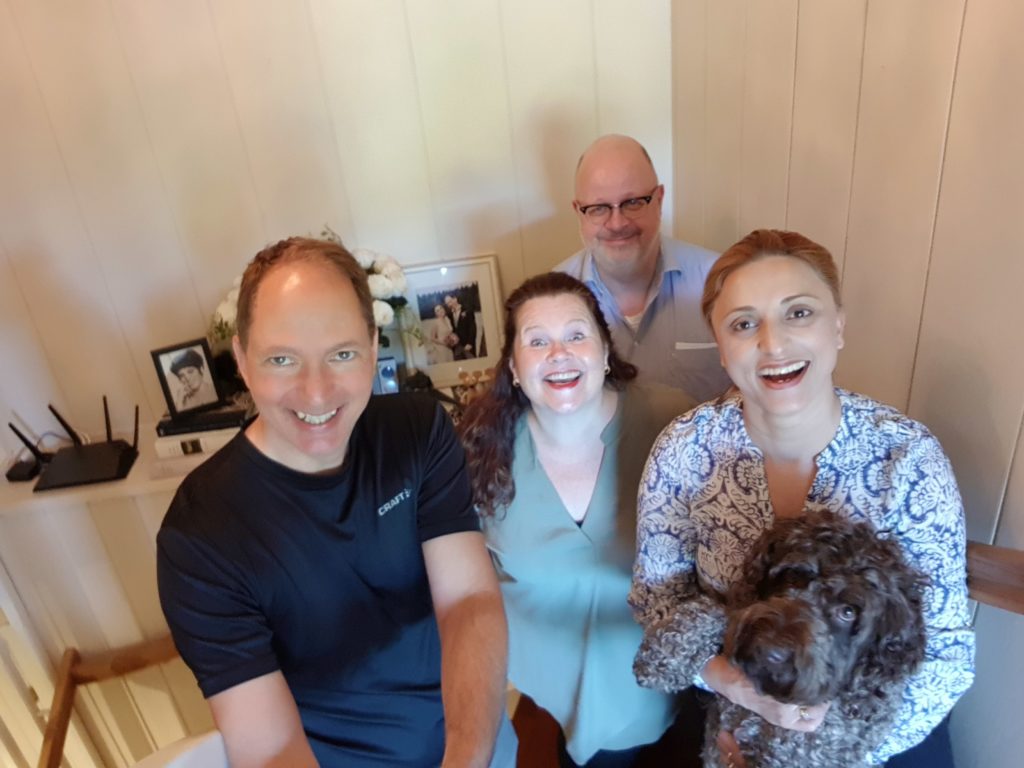 We went towards the centre of Oslo (which they call, of course, “Sentrum”), where we arrived at 11:00. The last time I’d ever really been there was with my then girlfriend in the summer of 1993. Our impression of the capital city of Norway had been, let’s say, unimpressive. We now found out that this was largely caused by the fact that we had only spent an hour’s time between the city’s Railway Station and the Bus Station that was to take us further north, whereas all the interesting stuff is located south of the railroad tracks. So that is where we started our discovery of the nation’s capital now.
We went towards the centre of Oslo (which they call, of course, “Sentrum”), where we arrived at 11:00. The last time I’d ever really been there was with my then girlfriend in the summer of 1993. Our impression of the capital city of Norway had been, let’s say, unimpressive. We now found out that this was largely caused by the fact that we had only spent an hour’s time between the city’s Railway Station and the Bus Station that was to take us further north, whereas all the interesting stuff is located south of the railroad tracks. So that is where we started our discovery of the nation’s capital now.
We walked towards the harbour, at the east side of which we saw the Opera Building. Its most striking feature was a huge sloping roof which could be walked onto if you wanted to enjoy a view of the harbour unimpeded by traffic and the public at large. The marble, so Ronny proudly claimed via WhatsApp, was the same type as that from which Michaelangelo’s David was chiseled.
As the weather remained quite sunny and dry, we decided to take in a few other sights as well. Next up was Akershus Festning, a 13th-century fortress (also once a school, once a prison). Part of it was being renovated, so we settled by walking around it. Attempts at making a semi-distant selfie with the lone guard were unsuccessful, but at least Ruth managed to hug a tree in a small park specifically designated for people with such tastes. After that we set out towards the Royal Palace, which didn’t press our proper taste buttons so we continued instead in search of a place to press our proper taste buds. That became Brasserie La France (“Gallic cuisine in a traditional setting”). This was yet another baby step towards us learning to cope with Norwegian (perhaps Scandinavian?) prices, though, granted, this wasn’t exacly a backwater street where one might expect modest prices to begin with.
As of this paragraph I will try to abstain from remarks about prices, no matter how Dutch (or, for that matter, Scottish) this behaviour is.
After La France we needed a place to wait until we felt we really needed to get our trolleys back from the railway station lockers and get onto the train to Oslo Airport (“Lufthavn”). That became café Egon, practically next to the station.
Before we started this Norway trip I had started reading Jamie Lendino’s “Faster than Light – The Atari ST and the 16-Bit Revolution”. Although understandably less scene-centric than Marco Breddin’s “Borders” series, it was an interesting read that did mention a few legendary demo screws and, yes, Thalion. Lots of the Atari corporate background, too, with key players being interviewed. While sipping a large Coke at Egon’s, I finished this title and continued with Lendino’s “Adventure – The Atari 2600 at the Dawn of Console Gaming”. I never owned a 2600 and almost everything I read was new – and certainly “back to basics” when you consider the exceedingly limited technical specs that hardware had. An interesting read for sure.
Be that as it may, we now took a cheaper (…) train from Oslo Central Station to the Airport.
At 16:20 we went through security, and I even had to enter some new-fangled cylindrical piece of equipment that may have been an active (or passive) particle airport body scanner.
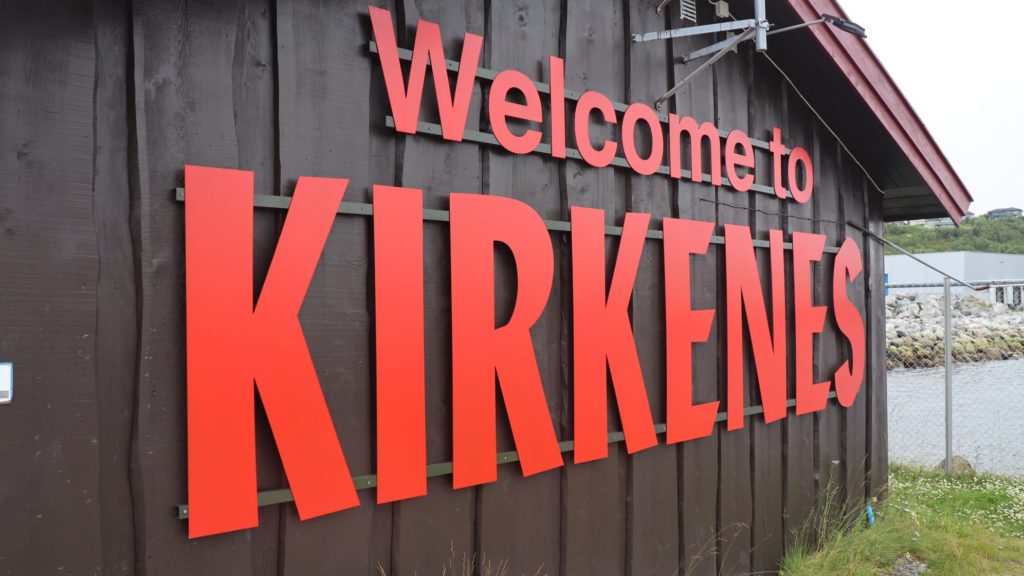 At 18:24, flight SK4478’s Boeing 737-7000 (thankfully not a 737 Max) ascended up and north towards Kirkenes, one of the most northern towns in Finnmark. When we landed at 20:20, we were glad to have taken warm coats with us – it was 7 degrees Celcius. The airport was a shack in front of hills shrouded in a blanket of clouds. Luggage retrieval, despite the airport basically consisting of one hangar, took a very long time. Thankfully we did manage to catch a transfer bus that drove to the town proper, what with it being about half an hour’s drive away. Checking into Scandic Kirkenes was a bit of a survival-of-the-fittest situation – instead of merely wondering why people had been running from the bus to the check-in desk, I should have joined them and run a bit myself.
At 18:24, flight SK4478’s Boeing 737-7000 (thankfully not a 737 Max) ascended up and north towards Kirkenes, one of the most northern towns in Finnmark. When we landed at 20:20, we were glad to have taken warm coats with us – it was 7 degrees Celcius. The airport was a shack in front of hills shrouded in a blanket of clouds. Luggage retrieval, despite the airport basically consisting of one hangar, took a very long time. Thankfully we did manage to catch a transfer bus that drove to the town proper, what with it being about half an hour’s drive away. Checking into Scandic Kirkenes was a bit of a survival-of-the-fittest situation – instead of merely wondering why people had been running from the bus to the check-in desk, I should have joined them and run a bit myself.
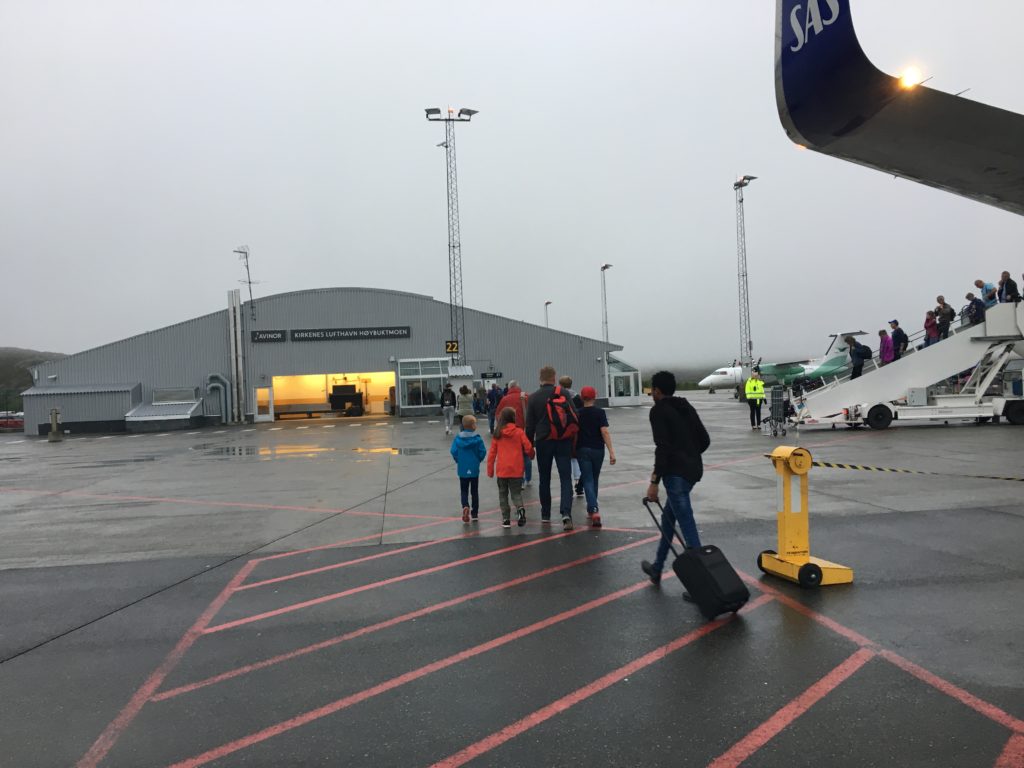 Kirkenes itself, at 21:45, was pretty depressing and sad to behold. It wasn’t yet dark, but the streets were utterly deserted. Google had pointed us towards two possible restaurants where the kitchens wouldn’t close until 22:00 or later. The one we got to was “Surf and Turf”, a restaurant where we were the final and last customers of the day. Unfortunately they had run out of King Crab starters that we would have liked, but the spicy reindeer-brunost pasta dish was delicious! Never had reindeer before, but it wouldn’t be the last time.
Kirkenes itself, at 21:45, was pretty depressing and sad to behold. It wasn’t yet dark, but the streets were utterly deserted. Google had pointed us towards two possible restaurants where the kitchens wouldn’t close until 22:00 or later. The one we got to was “Surf and Turf”, a restaurant where we were the final and last customers of the day. Unfortunately they had run out of King Crab starters that we would have liked, but the spicy reindeer-brunost pasta dish was delicious! Never had reindeer before, but it wouldn’t be the last time.
But Kirkenes at night, well, let’s say it’s easy to imagine youths spending most of their time trying to find an excuse to move Anywhere But There.
Back in the hotel, I finished the 2600 book. It left me with a feeling of admiration for the programmers of the time – in particular the people who founded Activision – and the desire to install a 2600 emulator after getting back home. But first Hurtigruten, and even before that, sleep.
Wednesday, 14 August.
And sleep I did, like a log, before having the excellent Scandic Kirkenes breakfast buffet the reviews on the internet – quite rightly – all rave about. Breakfast on its own is just about enough reason to stay at this hotel if you ever find yourself north of Amsterdam (much in the same way I always advise people to visit Alhambra if they ever go south of Amsterdam).
Ruth usually likes to scavenge local supermarkets to see what local goods are like. One such local goods was something you’d call reindeer jerky (really called “Reinsnacks”, which certainly makes sense). We bought some, and I thought it was quite enjoyable.
We more or less accidentally ran into the transfer bus towards the harbour where the Hurtigruten ship MS Kong Harald lay, waiting for the start of its southward journey to Bergen.
This moment in the story is perhaps opportune to tell you something about Hurtigruten. It is basically a company that, among other things, organises cruises from Bergen to Kirkenes and back. They also do cruises around Greenland, Svalbard (Spitsbergen) and Antarctica. The ships, I am told, do not only cater for tourists but also provide mail and other transport services for the many municipalities on the 1500 miles it covers along the Norwegian coastline. And when I say “Norwegian coastline” I really mean to say “spectacularly formed, wild, rugged, impressive, beautiful collection of fjords that in Norway comprise what other countries would merely call a coastline”.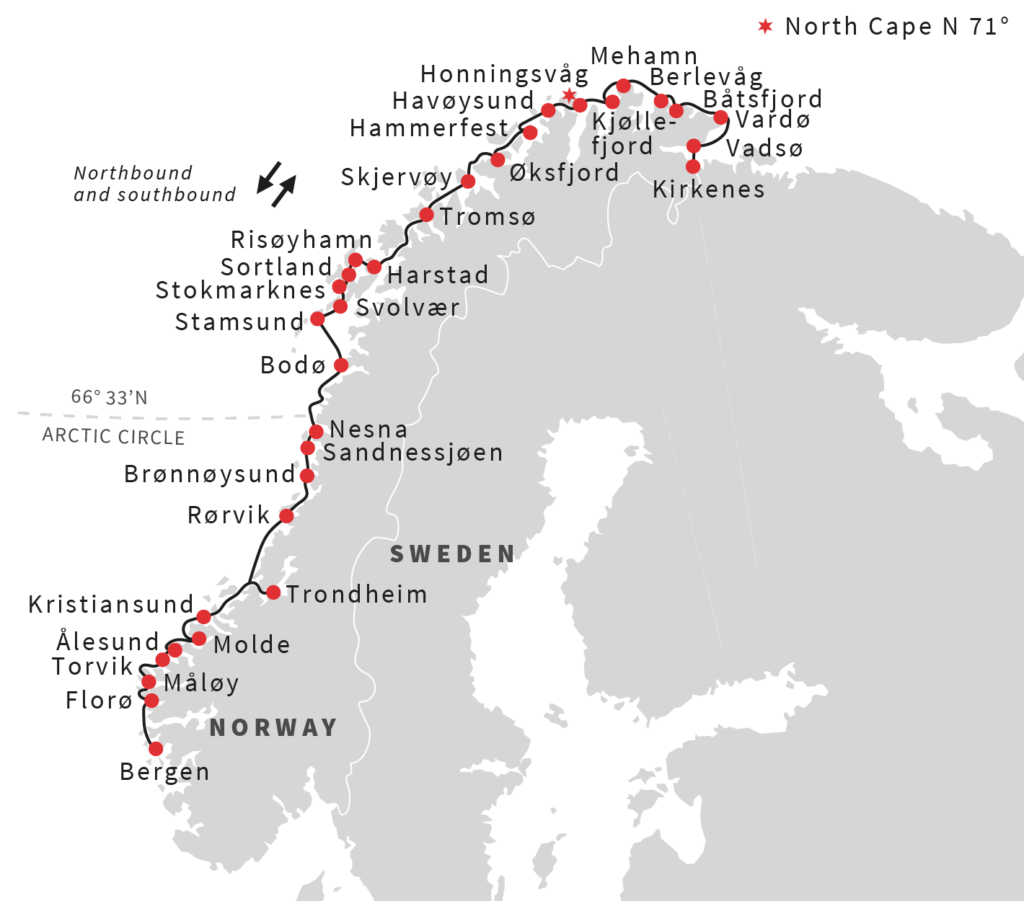 How did I find out about Hurtigruten? This is a question Ruth also asked me. The answer takes me back to 1991, when the band Fear of God released their seminal debut album, “Within the Veil”. Even with Metallica’s black album released that same year, “Within the Veil” was more impressive and generally more awesome. The band’s sophomore album, 1994’s “Toxic Voodoo”, was a whole lot less impressive and generally not quite so awesome. However, it did not prevent me from taking over development of the sortof official Fear of God website previously run by Kevin “Bl00d” Nunn.
How did I find out about Hurtigruten? This is a question Ruth also asked me. The answer takes me back to 1991, when the band Fear of God released their seminal debut album, “Within the Veil”. Even with Metallica’s black album released that same year, “Within the Veil” was more impressive and generally more awesome. The band’s sophomore album, 1994’s “Toxic Voodoo”, was a whole lot less impressive and generally not quite so awesome. However, it did not prevent me from taking over development of the sortof official Fear of God website previously run by Kevin “Bl00d” Nunn.
You must be wondering how Hurtigruten is going to fit into this extended anecdote. Did the band ever do a “11,204 Tons of Metal” cruise on Hurtigruten? Well, no, but do bear with me.
Once the site got more and more exposure among band fans I got contacted by a guy who was mentioned in the sleeve notes of “Toxic Voodoo” as Germany’s #1 Fear of God fan – Burkhard Krumkühler. Burkhard was (and is) seriously into female-fronted metal bands, as well as Kari Bremnes. Kari is a Norwegian singer who also wrote a song about Hurtigruten (on her album “Blå krukke”, 1989). I had already divulged my love of Norway to him, so Burkhard mentioned Hurtigruten and e-mailed me a link to a video stream of one of those voyages. At that moment, doing a Hurtigruten cruise of the Norwegian coastline became an item on my bucket list. And last Christmas I had saved up enough money to actually book it, albeit a slimmed-down version of just the southbound part. So that’s how Hurtigruten happened for me. I mean for Ruth and me – though Ruth was really just a more or less unwitting (if appreciative) victim.
Here’s the video link Burkhard sent me that hooked me. Beware…it might hook you too!
Back to Kirkenes, around noon. The sky was overcast. In novels, such weather is typically described when introducing a mystery, or a murder, perhaps both. People with rucksacks and/or trolleys, hopefully not all too bent on murder, started gathering on the quay in front of the 1993-built (and 2016-refurbished), 121.8-metre-long, 11,204-tonne, 498-bed MS Kong Harald, named after the reigning monarch of Norway. We noticed right away that the average age of those around us was, um, above the retirement cut-off. Some of the less socially proficient retirees blankly stared at us. It wasn’t until later that day that we spotted a family or two. In total there may have been at most half a dozen pre-teens and about a dozen teens on board.
At 12:25, we had checked into cabin 325, which was directly to the left of the ship’s loading/unloading portal, and the vessel cast off. We were checked in by Jacqueline Seagal – or at least someone who was called Jacqueline and who very much looked like she could be Steven Seagal’s sister. Upon check-in, we got a key card which, after having been linked to my credit card, was also the way to easily make on-board purchases.
Now the cabins need a special mention. They are obviously very compact – especially the shower – but they are also quite luxurious. We had a mid-range cabin on the outside of the ship, so we had a nice view of whatever bit of sea or fjord was available for viewing. And the bathroom floor was heated. There is something intrinsically luxurious and somehow peaceful in being able to, um, relieve yourself while your feet get warmed.
Most of the luncheons we enjoyed while on the Kong Harald were of the buffet variety. You could chose from quite a wide selection of hot and cold dishes, and usually there was quite an extensive choice of local produce. Even if you’d never tasted something before (like I hadn’t ever tried herring in curry sauce), you could just have a little to try, have more if it was, as Borat would say, “success!” Buffets rule. And not only was the variety a big plus, the taste was, too. Obviously, the catering side of Hurtigruten must be supported by a very capable chef and kitchen team. Although most dinners and some lunches were three-course (not buffet) and therefore fixed, there was never any reason other than to praise their talents.
Later that day we left the ship for the first time. In Vardø, the ship stayed for about 45 minutes while us tourists could visit the small local fortress, “Vardøhus Fortress”, a modest museum surrounded by a stone wall, guarded by a statue of King Haakon VII (1905-1957). It is was located on a hillock with a gentle slope. Everyone had to hurry, as you were supposed to be back on the ship 10 minutes before departure.
It was the first time I tried out my school’s Garmin VIRB 360° camera. I had resolved to use this trip to beautiful Norway as a starting point for some really cool 360° video clips to be used in our “Virtual Reality Club” (of which I am the supporting teacher). Nothing except the real thing beats such a video if you want to remember what a certain place was like. Vardø wasn’t spectacular, but it was a good place to try out what the camera could do, and how it functioned. The clips are a bit short, but at leas they give an impression.
We ultimately had to hurry back to make it in time. Mrs Seagal told off a few trembling people who arrived just within the 10-minute-early time slot (“the ship will really leave without you!”). We vouched to be in time, always!
I would like to briefly dwell on my physical state here, in particular of my left heel.
About a year and a half ago I did something to my left foot that caused the heel to feel uncomfortable (and even painful) after a prolonged period of non-use (read: almost every time I get up in the morning). After dance lessons or a day with much walking, it’s at its worst. The oddest thing, to me, is that it feels better after some use. I do intend to go to my GP soon, it’s just that I wasn’t raised to go to the doctor for any little thing. And, really, it’s already feeling a lot better as I am writing this…
Anyway, while Ruth ambled comfortably to and from the ship, I more sortof limped, feeling like old age had finally caught up on me. I was already blending right in with the old folk around us.
In the evening we had our first dinner at the MS Kong Harald. They always strived to provide us with locale produce, like I said earlier, and as we were sailing around Finnmark this included reindeer. Lovely, and much less gamey-tasting than deer for example. Dinner, however, also made us discover the only thing about Hurtigruten that wasn’t quite perfect.
In the Hurtigruten price structure. Everything is divided into Basic, Select and Platinum. We had gone for Select, as that allows you to choose a cabin type, get complimentary tea and coffee, and of course the only thing below oxygen in our Maslow’s hierachy of needs, Wifi. Platinum, among other things, boasts two free excursions, dining á la carte, a welcome basket with champagne, private airport transfers, a visit to the ship’s bridge, priority embarking/disembarking and an activity outdoor clothing package. Together with the obviously much steeper price, the Platinum package includes especially things that are really quite unnecessary. One of the things Platinum also offers, however, is “inclusive drinks package with dinner”. And that, we both felt, is really something that should have been included in the “Full Board” description of Select. This was, in fact, the first time I had been on holiday in a “Full Board” type situation without free drinks all day around.
After dinner we went back to our cabin, as the next day would start early for the “Breakfast at the North Cape” excursion.
I started reading my next book, Hans Rosling’s “Factfulness – Ten Reasons We’re Wrong About the World – and Why Things Are Better Than You Think”. It quickly became apparent that this was a life-changing book, and in fact I think you should definitely also read it. Those who are familiar with me know I am no stranger to hyperbole, but believe me that you should all read this book as quickly as you possibly can. Read a review somewhere, order it right away, read it. It will change your view of the world utterly, and will also make you feel a whole lot better in general. If there is one thing I’d really like you to take away from this whole Hurtigruten story, it’s the utterly non-Hurtigruten-related fact that you ought to read this book. You don’t know it yet, but you owe it to yourself and to the world.
I did not sleep well. Not on account of the book, but on account of wanting to fall asleep as quickly as possible. We knew we had to get up at 05:00.
Thursday, 15 August.
We got an unexpected wake-up call at 4:45, which startled me from a dreamless semi-sleep. As we got woken up 15 minutes before we had personally intended to, a feeling of relaxedness settled over us. No need to hurry, really, was there? The ship arrived at the fog-enshrouded town of Honningsvåg, starting point for our first excursion. Despite our feeling not too hurried, Ruth was the last off the ship and we needed to break into a brisk trot to make it to the bus.
The Finnmark area of Norway barely has any trees and looks barren. Most vegetation you’ll see is moss. Left and right are impressive rock formations, little lakes, a waterfall here or there. Good thing we had those coats, for it was 9 degrees or thereabouts. Guide Petter (or Petr?) spoke of people getting stuck in the snow with the army having to be called in, about the Sami people, and about low average temperatures on sea and on land. I always tell Ruth I could live anywhere as long as there’s good internet, even (or perhaps “especially”) if there are barely any people, but perhaps this area of Finnmark does not fall within my usual sweeping statement.
The occasional reindeer would be spotted close to the bus, which resulted in every single person in the bus whipping out their cameras or smartphones and snapping away. Though Petter predicted it, nobody believed we would soon almost be tired of seeing reindeer. He also told us the water temperature around here was 24 degrees – 8 in the morning, 8 in the afternoon and 8 in the evening :-).
At 06:10 we arrived at the North Cape, at 71º9’53.7552” N latitude. When the bus parked in front of the visitor centre – erected around the spot where Siam (Thailand) king Chulalongkorn (Rama V) carved his name in a rock during his visit in July 1907 – we barely even saw it, that’s how thick the fog was. So the view from the North Cape was correspondingly limited, but we did gather around the globe built on its very northern edge. Although it was too late for the midnight sun and too early for the famed Northern Lights, it felt like a pretty special place to be.
Sorry about the wind noise. I couldn’t figure out how to zero the sound using the VIRB Edit software (which, to be honest, is quite basic).
The visitor centre boasted an exposition of the history of the North Cape, as well as the demise of the German WWII battle cruise Scharnhorst (was sunk off the coast there). We also had breakfast there, where I had my first pickled herring in tomato sauce experience (I’d have more of that on future occcasions!).
At about 07:45 we left the North Cape. The ship had obviously already set sail from Honningvåg while we were doing this excursion, so we would be dropped off on the MS Kong Harald’s next port of call, Hammerfest – which I reckoned was a very cool name for a power metal festival. But we had nearly 4 hours ahead of us, with a short break in Olderfjord (where we resisted buying a reindeer skin, which in hindsight we regretted a little). During those hours Petter regaled us with various facts about Norway, Finnmark, the Sami people, reindeer, and the scorched earth policy of the retreating German Wehrmacht in 1944 (“das war kein Spaß”).
And we saw reindeer. Calves, proudly-antlered bulls, cows, whole herds, and sometimes a bunch that leisurely blocked the road and took a little while to leave. Photo ops galore! I found myself deleting the reindeer pics I had made earlier that day.
It continued to be very foggy and there was a lot of wind (hence so few trees, Petter revealed). We also came past a collection of stones sitting on a coast that looked remarkably like a troll. Norwegians have something with trolls. And vikings. And reindeer. And moose. Ruth was a bit disappointed when we didn’t get to see any of the latter.
A thought about those Vikings…1400 years ago the Viking invasions of Europe were not exactly welcome, and the inhabitants of the European coasts thought they were harbingers of doom, starting the end of the world. They slaughtered and pillaged like there was no tomorrow. Nothing like the romanticized picture of Vikings that was shaped in the last two centuries. How long will it take until mainstream Russians have T-shirts with “Home of Stalin”, or Germans have T-shirts sporting a “Country of the Nazis” slogan? Just made me wonder. Hopefully more than 1400 years, though.
We arrived at the city of Hammerfest when it was almost noon. Hammerfest has the peculiarly shaped Hammerfest Kirke, re-built by Germans in 1961 after they had burnt it down behind them (as you do) in 1944. Probably not the same Germans. Its odd shape was, apparently, inspired by the typical shape of a stockfish drying flake (the lovely German translation and potentially cool Hangman word being “Stockfischtrockengestell”).
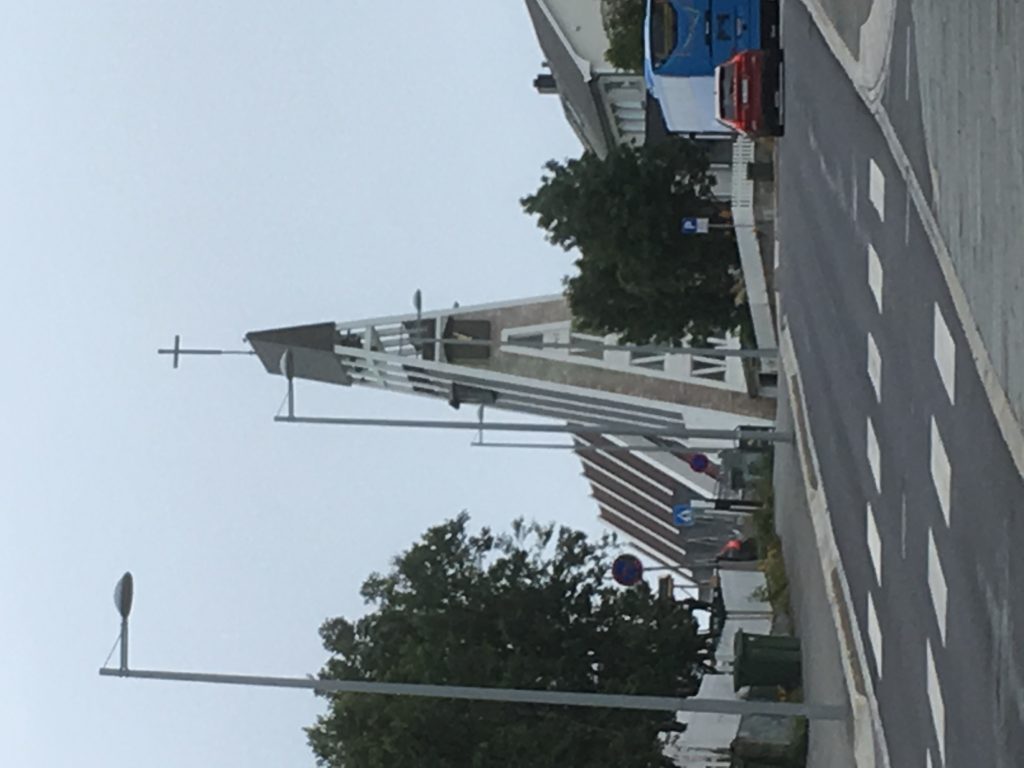 Sorry about the tilted thumbnail, but if you click on it, it will display right.
Sorry about the tilted thumbnail, but if you click on it, it will display right.
The ship didn’t leave until 12:30, so we walked through town a bit. We visited the famous “Royal and Ancient Polar Bear Society” and got a bunch of picture postcards there, to send to the home front. We did not become members of said society, though we’d heard it was the in thing for tourists to do. We did get the postcards stamped with a special polar bear society stamp, however.
We spent most of the afternoon reading aboard the ship. There was a pretty homey part of deck 7 where you could have a drink, which is what we did. Rosling’s book continued to captivate and educate as I progressed through its chapters. Ruth had been reading Isabelle Allende’s “The House of the Spirits” and continued throughout the trip. The Hurtigruten home red wine was lovely, the dry white one was pretty ordinary.
In the evening, we had upgraded our regular meal to a one-off King Crab meal. After the slight disappointment of not being able to get the King Crab starter in Kirkenes, certainly after we had heard so many stories about King Crab multiplying like crazy and overrunning native species in the fjords, we had figured the Norwegians would be pushing us to eat them left and right, and practically for free (as we’d be doing them a service!). Well, nothing could be further from the truth. Be that as it may, I think we got a whole King Crab, nicely dissected and pre-broken for our culinary delight.
If you’ve never had King Crab, the taste can be compared to lobster but it’s a little sweeter to my palate. The meat is structured much more nicely when compared to regular crab, which makes it much easier to eat. These are first world problems, I know (though Hans Rosling would strongly discourage me from using any such description of a developed country, as well as the word “developed country”), but I can’t help myself.
After dinner, back in the cabin, I finished the “Factfulness” book before going to sleep.
Friday, 16 August.
We woke up before eight. The nights above the Arctic Circle are really much lighter, despite the Midnight Sun having climaxed as far back as June 21st. The curtains in front of our porthole also, let’s say, functioned modestly. The entire night had been extremely comfortable sailing. The ship did not always sail on open sea, instead choosing a more sheltered route between islands and the mainland. The sea was virtually as smooth as a swimming pool.
The next port of call was Harstad, as the ship crept closer and closer to the Lofoten islands to the south. It was only a very short stop, marred by some difficulties disembarking due to an incessant alarm going off to indicate that something wasn’t right with the gangplank mechanism. Ruth in fact had to exit via the car deck door. We barely had enough time to admire the local habit of hanging colourful clothes across the streets and run to a local “Mix” shop to get some Coke and 7up. Did make a 360º video at the quay…
We were back just in time to prevent Mrs Seagal’s wrath.
After Harstad we had our first breakfast on the ship. Like lunch and dinner, this was extremely varied and satisfying. One always tends to eat too much at these breakfast buffets, but it was impossible to resist the temptation of having a warm English-style breakfast, followed by some bits of brie and blue cheese, topped off by some fruit yoghurt. Those bits in the brain that tell you you need to eat as much as possible just in case there’ll be lean years ahead – an ancient survival mechanism – run amok in this type of situation.
Next, we sailed a bit to the northwest so go to the next harbour on the route, Risøyhamn. The voyage took us through the quite narrow Raftsund strait, artificially dredged through where, until not too long ago, one could walk from one island (Andøya?) to another (Hinnøya?) at low tide.
The video clips show the approach through Raftsund Strait and the approach of and departure from Risøyhamn.
We did not leave the ship during its short stop there, and instead elected to have an apres-lunch snooze in our cabin. I started reading my next book – the enlightening, educational and very humorous “Mythos” by the wonderful Stephen Fry. This actor and writer is not admired half enough, I find. This book makes Greek mythology and its tremendous influence on our language accessible to otherwise classically illiterate readers such as myself.
Five o’clock came closer and closer – the time at which we’d enter what expedition team member Heinz called one of the most unmissable places to see during the voyage, Trollfjord. According to legend, this fjord was shaped by one giant axe swing when a troll called Vågakallen got angry when his neighbour’s goats trespassed on his property. We were all urged to go on deck, which is indeed what most people did as we sailed past Olvøya and then rounded Brakøya to enter this fjord. The weather was lovely and just warm enough.
Trollfjord is particularly picturesque due to its narrow entrance among steep cliffs and its compact, visually spectacular and somehow ‘private’ interior. It was made even more special by two sea eagles that we saw soaring between its steep sides. I made a nearly-10-minute 360° clip when the ship exited the Trollfjord, too, some of the most stunning footage I thought. It was a magic and romantic experience, made all the more memorable because I was experiencing it with the love of my life.
Not too long afterwards, dinner included Brunost icecream, which tasted far nicer than I would have imagined back in 1989. And after dinner it was time to join our second excursion, which we had only decided to partake in more or less on a whim earlier that afternoon – the Lofoten Panorama bus excursion which started in the next harbour the boat stopped at, around 18:00, Svolvær.
There was a bit of a kerfuffle around the fact that two buses were needed but there was only one (we later heard this was solved). This seemed to affect the demeanour of our guide somewhat, though it did not affect the content and extent of the information about the Lofoten islands she shared with us while we drove across two major (Austvågøya and Vestvågøy) and a smaller (Gimsøya) islands of the archipelago.
Our first stop was a small fishing village called Henningsvær, located at the far south end of Austvågøya. It could be reached along a practically Caribbean-looking white-sand-with-clear-green-water (but 9 degrees Celcius water temperature) beach and two one-way-traffic bridges. Dusk was upon us, and some rain as well, but just before we left Henningsvær again we were treated to a pretty cool sunset.
The rest of the trip was less eventful, though no less interesting. We took a small (nicotine-induced?) break upon reaching the isle of Gimsøya, and another near Bøstad (with quite a breathtaking view, see below). We drove along the Viking Museum, which was based in or near a large restored viking dwelling, before turning east to the village of Stamsund where the MS Kong Harald lay waiting for us, brightly illuminated in the dark.
After departure, it seemed like we got into a bit of a storm – though no sailor worth his salt would likely describe it as such – with a lot of rain. We read a bit while sitting in the Explorer Lounge (for those among you who harbour bad memories of people getting up early to put their towels on deck chairs near swimming pools, the Explorer Lounge was a slightly less blatant maritime version of that, due to the highly desirable prime seats with panoramic views equalled only by those from the captain’s bridge).
Saturday, 17 August.
Again, we woke quite early. Breakfast happened at 08:30, after which the first event of note was the crossing of the Arctic Circle. Did you know that the position of the Arctic Circle is not fixed? As of 20 August 2019, it runs 66°33′47.7″ north of the Equator. Its latitude depends on the Earth’s axial tilt, which fluctuates within a margin of more than 2° over a 41,000-year period, due to tidal forces resulting from the orbit of the Moon. Consequently, the Arctic Circle is currently drifting northwards at a speed of about 15 metres per year. Nevertheless, a globe on Vikingen island functions as an Arctic Circle Monument. We passed it as breakfast was drawing to a close, at 08:52.
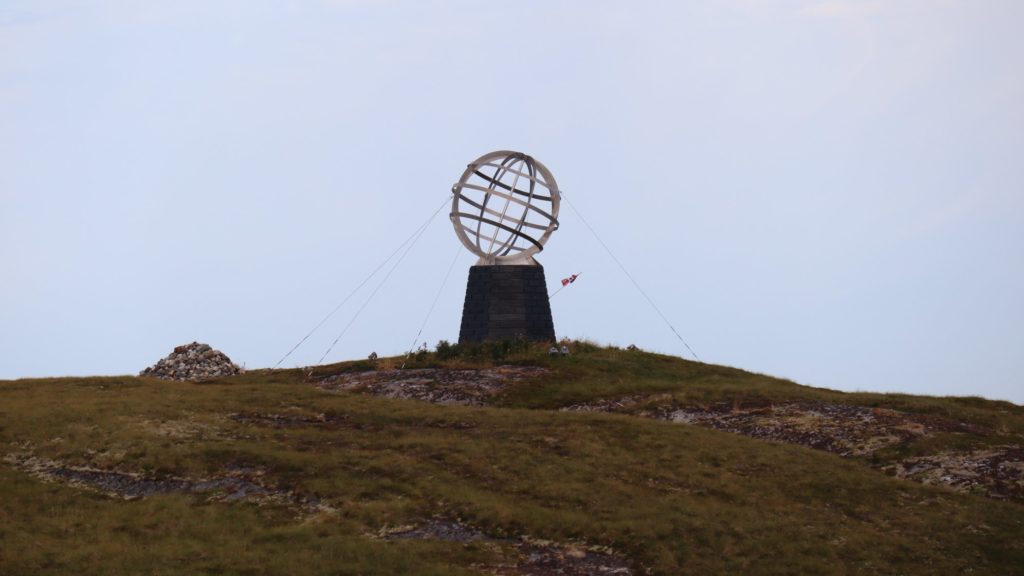 Crossing the Arctic Circle, at least on this particular ship, comes with a certain ritual. Pictures of the northbound journey seemed to indicate this involving ice cold water on one’s head. The southbound version was arguably less traumatic – having a spoonful of cod liver oil with a champagne chaser. We duly partook, and especially Ruth’s contorted face was later immortalised as part of the Hurtigruten Voyage 20 souvenir video.
Crossing the Arctic Circle, at least on this particular ship, comes with a certain ritual. Pictures of the northbound journey seemed to indicate this involving ice cold water on one’s head. The southbound version was arguably less traumatic – having a spoonful of cod liver oil with a champagne chaser. We duly partook, and especially Ruth’s contorted face was later immortalised as part of the Hurtigruten Voyage 20 souvenir video.
 At 11:51, during the MS Kong Harald brief(!) stay at Sandnessjøen, we ran towards the local “Mix” for something to drink and made it back in time for departure.
At 11:51, during the MS Kong Harald brief(!) stay at Sandnessjøen, we ran towards the local “Mix” for something to drink and made it back in time for departure.
After 12:30, the cruise passed a mountain range called “The Seven Sisters”. The range is so called because it features 7 distinct peaks, protecting the hinterland from severe weather phenomena.
Not too long after another very satisfying lunch, we alighted the ship in the village that claims to be practically in the middle of the Norwegian coast, Brønnøysund. Tourist sight number two, according to Google, was the Brønnøysund bridge. According to the usually infallible Google Maps, it was supposed to be located at a 4-minute walk from where we were. It seemed further away as we looked south to where the Fv54 road crossed the water, but nonetheless we set out full of hope.
It was after over 20 minutes’ walking that we decided to see if we could actually try to hitchhike there. This would then hopefully also prevent us from actually having to ascend that bridge (the highest centre span has a clearance of 30 metres above sea level). Also, my left heel was gently killing me. Even more importantly, however, the time the ship would remain in port was slowly running out and we also had to make it back before it left (at the time we thought we had an hour and a half available, though it later turned out we had two and a half hours at our disposal).
A very friendly lady in a large Volvo proved once more that Norwegians are very friendly folk by dropping us off at the other side of the bridge. Stopping in the middle of the bridge was not allowed and potentially dangerous, but ascending the bridge from the other side was much less challenging. In the end we arrived at the highest point of the bridge just a tad earlier than two rather much more sporty looking girls from the ship (who had not hitchhiked) got there. Minor victory!
The view was spectacular enough to warrant whipping out the 360° camera again.
We walked back, if I may add, entirely under our own steam and got something to drink at a local shopping mall as well. We spotted the girls jogging back. One can but frown sometimes, can’t one?
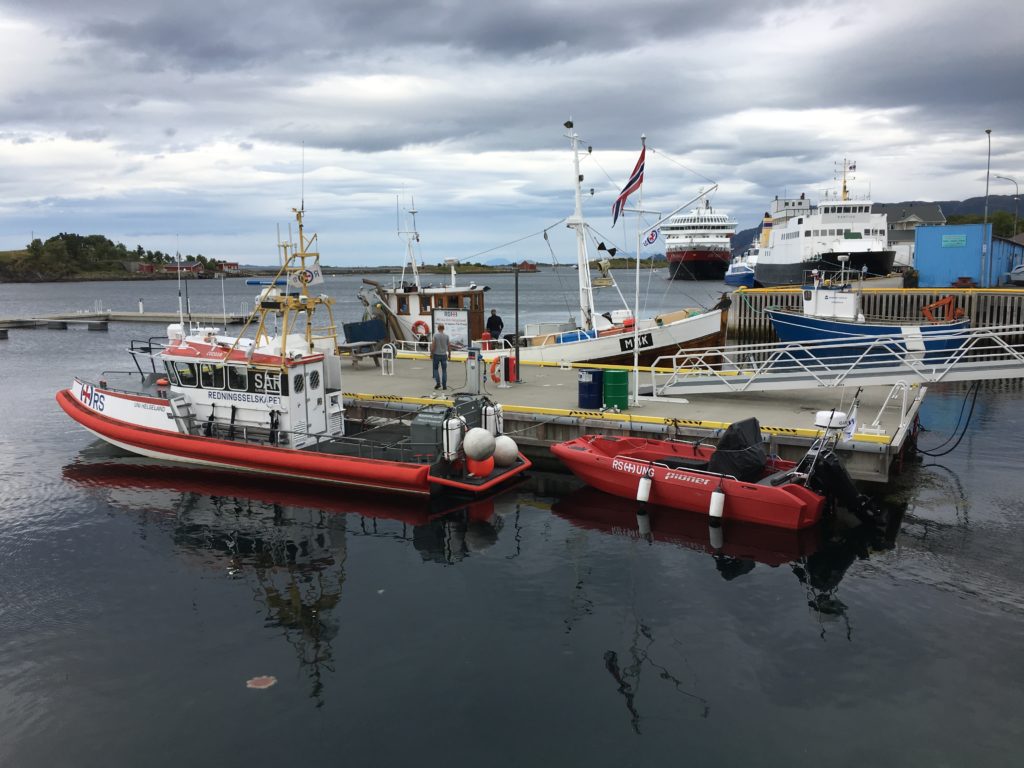 After the ship’s departure, we saw the Brønnøysund bridge from sea level as the ship boldly continued forth to tourist sight number one, Torghatten. Sure glad we didn’t decide to think we were able to walk there – the distance was perhaps 15 kilometres.
After the ship’s departure, we saw the Brønnøysund bridge from sea level as the ship boldly continued forth to tourist sight number one, Torghatten. Sure glad we didn’t decide to think we were able to walk there – the distance was perhaps 15 kilometres.
On its way to Torghatten, by the by, the MS Kong Harald passed Brønnøysund tourist sight number three, Steinar Breiflabb. It is Brønnøy’s contribution to Artscape Nordland. The sculpture was created by the Swedish/French artist Erik Dietman, and is a landscape installation shaped like a 70 m (230 ft) long stone fish.
Torghatten, then. This is an impressive granite mountain with a naturally formed, 35-metre-high tunnel through its centre. Legend would have a troll-based story behind the tunnel , of course.
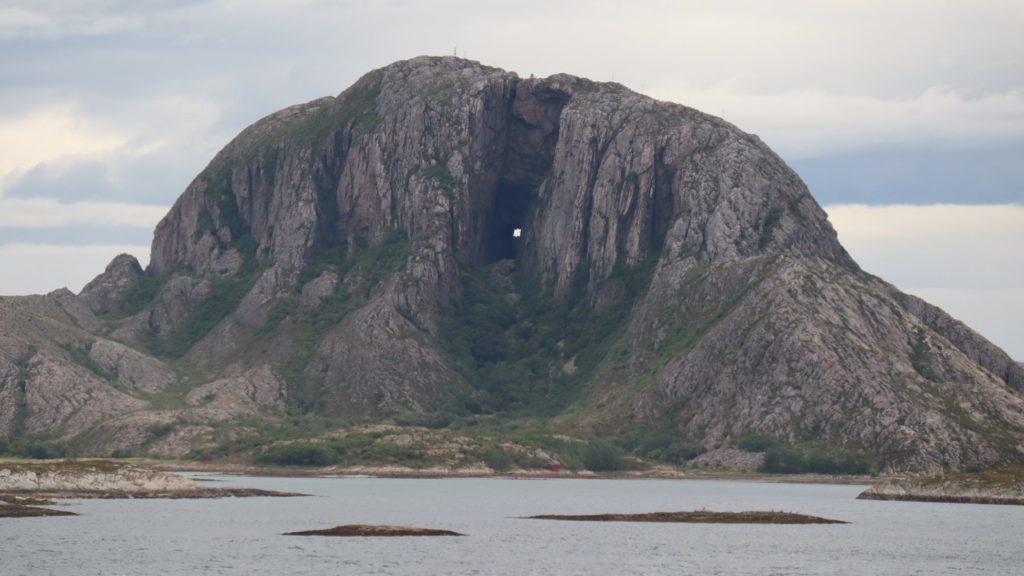 It wasn’t crowded at the ship’s stern at all, unlike when we had entered Trollfjord. This may have been on account of most interested people having visited the actual Torghatten tunnel during the day’s excursion, or the gale-force winds that rocked the front of the ship. Nonetheless, we enjoyed each other’s company enough to do a spontaneous little jive, in our warm coats, hoods pulled up, strands of Ruth’s hair whipping. The ship went there and then back out along Brønnøysund, on its way to the next harbour, Rørvik (which was at night, and we didn’t leave the ship).
It wasn’t crowded at the ship’s stern at all, unlike when we had entered Trollfjord. This may have been on account of most interested people having visited the actual Torghatten tunnel during the day’s excursion, or the gale-force winds that rocked the front of the ship. Nonetheless, we enjoyed each other’s company enough to do a spontaneous little jive, in our warm coats, hoods pulled up, strands of Ruth’s hair whipping. The ship went there and then back out along Brønnøysund, on its way to the next harbour, Rørvik (which was at night, and we didn’t leave the ship).
At dinner, the time until which was spent reading in the Explorer Lounge, we decided to splash out a little on a bottle of Chablis. Because quite a few people were set to leave at the next major harbour, Trondheim, there was some sort of celebration. The main crew, including captain Asbjørn Dalan, were there for a goodbye speech followed by “skol” all around. And I say “all around”, but my enthusiastically lifted glass was pathetically kept hanging by all and sundry. That is, until the friendliest, most-often-smiling waitress, ‘skol!’ed’ me.
At the end of dinner we hadn’t finished our wine. A waitress was happy to put it back in the fridge for a later occasion – such a nice service.
Sunday, 18 August.
We were awoken by the sound of the entry/exit hatch opening creakingly at 06:45. We wanted to go into Trondheim, but there was no reason to hurry as the ship would be in its berth for over 3 hours. So we freshened up, exited the ship and took a taxi towards the Gothic Nidaros Cathedral in the old town. It was Sunday early in the morning so there was barely anyone to be seen. The taxi driver was enthusiastically explaining stuff about the town, in particular about something that could be seen on the left, when a car coming from the right made a condensed version of our lives flash before our eyes. A crash was barely averted, though our cabby could easily have died a horrible death if looks had been able to kill.
We left the cab onto a scene entirely bereft of other life except for literal early birds. It was exactly the kind of atmosphere you find after a long night – something may have happened in the night, but early dawn holds only the promise of tranquillity (or, in the case of a post-party scenario, a hangover). We walked around the cathedral, where we now spotted an anonymous reading Norwegiëtte who remained calmly unperturbed by our camera-centric tourist behaviour. The cabby had also advised us to check out the wooden houses of the old town, so we crossed the Old Town Bridge (“Gamle Bybro”) in its general direction. Very picturesque, again, and thankfully it only rained a little now and then. So much picture postcard material all around us.
Right then and there, surrounded by old Norwegian Trondheim, my iPhone told me it wanted to update to iOS 12.4, so I told it to. The last time I was in Norway it would still be more than a year until I would first use the internet myself, let alone 4G mobile internet. Back then, a current-day modern smartphone such as many of us have right now was the stuff of insanely progressive science fiction. My world consisted of a computer that had 4 megabytes of RAM, and a hard disk featuring 60 Mb worth of storage capacity was just about the best you could get (and you’d pay through the nose for it!). Times have certainly been a-changing.
We decided to head back towards the harbour. Since there was no real hurry, we figured we might find a cab, or we might not. Imagine our surprise when we found our old cabby friend again, still alive, still operating from the same miraculously dent-free car. We decided to tempt the gods by asking him to drive us back to the MS Kong Harald, where we arrived alive and well to have a 9:00 breakfast.
Not long after we started, the ship departed Trondheim. Upon our leaving the harbour, Hurtigruten sister ship Richard With (named after the man who started Hurtigruten in 1893) made berth there. The ships exchanged customary hooting sounds as we sailed through Trondheim Fjord on our way to Kristiansund, the next port of call we were supposed to arrive at late in the afternoon.
We went to the Explorer Lounge again, to read and have some tea. The beautiful coasts of Hitra and Smøle scrolled by on the port side, smooth like the sea under a blue sky with a bright summer sun. I had taken my earpods with me and listened to some metal (My Dying Bride in particular, who I have learned to re-appreciate after reading their extensive history in the great “A Harvest of Dread” box set), playing the occasional bit of air guitar and bobbing my head while continuing in Fry’s “Mythos”. Many moments of profound peace, Ruth reading next to me.
After lunch (where we enjoyed the remainder of the Chablis) the good weather didn’t relent. The sun, gentle breeze and bewitching scenery lured me outside on the deck again to do another 360° video clip, at 14:40 around Grisvàkøya. Honestly, anything less than 24/7 coverage of such a grand voyage is less than it deserves. You see one thing, and up comes the next thing that requires attention and admiration. Really, it would be exhausting if it weren’t also energy-inducingly gratifying.
Recharged and optimistic, I went back in and decided to ask Heinz of the expedition team if, despite my not having Platinum status, it would perhaps be allowed to visit the bridge and create a 360° video clip there. I showed him the camera to prove my worth. For school, you see, as I am after all a teacher and the guy who oversees the aforementioned Virtual Reality club. He dashed my hopes by saying that the day before had been the day on which interested people had been able to visit the bridge, and besides they really officially weren’t allowed to anymore. He said he would ask, but he expected little of it.
Another minor setback was the jacuzzi. We had been rejoiced by the fact that it had been available for use, after the Hurtigruten site having stated that it was unavailable during the week before we boarded. We had planned for a Sunday late-evening session of hot tubbing, but this day we heard that the jacuzzi had to be checked, cleaned and repaired on account of an unspecified member of the guests having had an accident with a piece of illicit glassware.
As afternoon changed into evening and the ship had visited Kristiansund, we sailed past the Atlantic Ocean Road. It’s a stretch of road, largely across bridges built between 1983 and 1989, that is known to have been called “the world’s best road trip” and awarded “Norwegian Construction of the Century”. The bridges often feature in automotive commercials. The MS Kong Harald sailed by at quite a distance from it, so it was difficult to behold from the deck.
After dinner we went to the Explorer Lounge for a bit of light reading and music. Well, “Mythos”, and expedition team’s Giske singing from behind a piano. Although Giske’s folk singing had sounded quite pleasurable when she launched into song at the end of our first day’s information meeting, we decided to give in to Morpheus’ siren song of sleep and head for the cabin after a few of Giske’s tunes. We read a bit there, and I ate my first (and, well, last) bar of Nero Lakrissjokolade (liquorice-filled chocolate).
In the night we sailed past Eggesbø island (past homestead of the late Gard Eggesbø Abrahamsen who died much too early almost exactly 5 years ago), to the east of which lay the village of Ørsta (past homestead of Ronny, where my previous two visits to Norway had largely or partly been spent).
Unfortunately the middle of the night also saw us dock for a meagre half hour at Ålesund. This was literally the one spot where every single person I had spoken to about our Hurtigruten adventure had advised us to climb the stairs up to Fjellstua to enjoy a stunning view of the whole town. Alas, this opportunity only avails itself to travellers on the northbound trip, when the ship stops there for a longer time. Instead we slept.
Monday, 19 August.
We woke up just after seven. This was to be our final day of Hurtigruten and, as can be said so dramatically, the beginning of the end. A look outside our porthole quickly revealed that the drama wasn’t restricted to my mind – it was raining outside.
At 10:00 we had to have vacated our cabin, after which we spent most of the time reading in the homey part at the aft of deck 7. With literally everyone out of their cabins, the ship now seemed quite crowded and it was more difficult to find a place to sit.
Although there had been no farewell celebrations the evening before, all those who were interested could decide to be in a group picture on the back of deck 7. This really brought a bit of a family atmosphere which just made it a bit sadder that the end of our Hurtigruten adventure had begun. As it was unexpectedly dry, Giske organised a quick spell of folk dancing on the same deck.
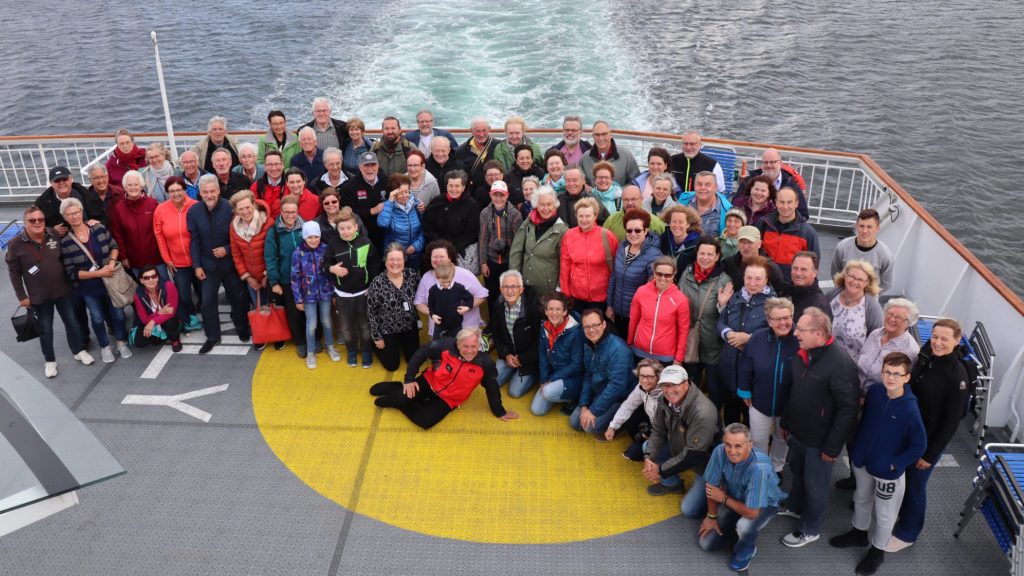 There was un expectedly positive announcement when I ran into Heinz, who told me it was possible to visit the bridge after all. He reiterated that this wasn’t customary at all, and that we had to be silent as part of the crew was asleep in the cabins adjacent to the bridge. Captain Dalan was very hospitable, if perhaps not entirely fluent in English, and insisted Ruth and I took turns on the captain’s throne. That was unexpectedly cool. I also whipped out the 360° camera for a shot of the bridge, which was what the original intention had been.
There was un expectedly positive announcement when I ran into Heinz, who told me it was possible to visit the bridge after all. He reiterated that this wasn’t customary at all, and that we had to be silent as part of the crew was asleep in the cabins adjacent to the bridge. Captain Dalan was very hospitable, if perhaps not entirely fluent in English, and insisted Ruth and I took turns on the captain’s throne. That was unexpectedly cool. I also whipped out the 360° camera for a shot of the bridge, which was what the original intention had been.
After the Last Lunch (doesn’t sound quite as solemn as “Last Supper”, but it sure felt like it) everyone gathered to, well, basically wait for their deck number to be called for debarcation in Norway’s second city, Bergen.
I forgot to make note of the time it was our turn, but I do remember that it was raining. We went through Bergen’s Hurtigruten Terminal to where the luggage had been put. Unfortunately the heavens opened at around that time so some of the luggage (including ours) got pelted on by rain.
Not too long afterwards we managed to hail a cab that brought us to Magic Hotel Solheimsviken, across the water in the south of Bergen. After checking in and ditching our luggage in our room – which was a smorgasbord of curiously slanted and asymmetrical design choices – we went to the nearest Bergen Light Rail (metro) station of Danmarks Plass. It took us straight to Byparken in the centre of town, each stop with its own little tune in its announcement message.
Before any fun could be had, we had to embark on a Quest for Socks. Several days earlier I had made the terminally stupid mistake to mention that Ruth’s son, Oscar, might want a little souvenir, perhaps Norwegian socks? Well, as our stay in Norway was drawing to a close, time was running out. To get it out of Ruth’s head, the best choice would be to find them now. After we had seen some of Bergen’s old town (Bryggen) and found a pair of socks that would hopefully satisfy all those involved, we sat down in a makeshift restaurant at the local Fish Market, run by Age Sørensen and a host of Spanish waiters and waitresses. I finally had whale steak (tastes somewhere between beef and liver). I liked it quite a bit, though it had irritating white thin stringy bits running right through it. This was exacerbated by the restaurant’s flimsy plastic cutlery. Ruth had King Crab which, obviously, was a unanimously positive experience.
Nature called afterwards, so we went to have dessert and find relief at a “Thank God it’s Friday” place. I had the best strawberry milkshake ever there. I am nearly 52, so I’d like to think, perhaps arrogantly, that lends weight to my judgement.
Back to the hotel, in bed by 20:35, probably asleep before nine. Somewhere in the very early morning, Ruth felt between the mattrasses and found a somewhat dried, partly eaten apple. This was about as welcome as the weather prediction which spoke of storms and rain for that day. Bergen, we supposed, was never going to be a highlight of the trip. Bergen was the city that made you forget it’s summer.
Tuesday, 20 August.
Not long after waking up from a very nice sleep, at 08:15, I emailed Kai Holst (he whose family hosted the second half of my 1993 visit to Norway) on behalf of his birthday.
After a pretty decent breakfast we stored our luggage at the hotel and found our way to the centre of town again. We got tickets for one of the city’s “hop-on/hop- off” bus services, “Sightseeing Bergen”. This included a ticket for the “Fløibanen”, a steeply ascending cable train towards the Fløyen mountain to the north-east of the city. At 320 metres, it yields a beautiful view of the whole of Bergen including its harbours. Needless to say, out came the 360° camera. This mountain with its spectacular vistas saved our Bergen experience from becoming unfortunately forgettable. The weather prediction had so far also proved wrong. Although the sky was overcast, it was mainly dry. We didn’t even need to wear our coats, on account of it being warm enough.
Below are two clips from the Fløyen mountain, both from the same vantage point. The images created by the front and back lenses of the camera are sown together by software so you always have fuzziness there. To allow everything to be seen sharply I took one shot with the front lens pointed west and one with it pointed south.
After taking the Fløibanen down, we proceeded with the rest of the hop-on/hop-off bus tour, though we hopped on nor off. We drove past the 15 most noteworthy tourist highlights, including Bryggen, the harbour, the Fish Market, Grieghallen, the university and others. I noticed there being a lot of Teslas on the roads of Bergen, which I suppose is a good thing for both Norway’s affluency and its environmental awareness.
As the trip’s end approached, so did rain. We ate at the same Fish Market restaurant again (paella and scampis) and went back to the hotel to get our luggage. We were running a tad late. The rain had disappeared again, thankfully.
Now we were on the final stretch of our journey that had brought us over 2000 kilometres north and then, much slower, 1500 kilometres south. We took the Bergen Light Rail in the other direction towards its final stop, “Bergen Lufhavn”. This was quite a bit further than going to Byparken, and it was not without its share of poking fun at the Norwegian language.
First we had “Sletten”, the name of the 4th stop. We thought that was very funny, as this basically means “sluts” (as in “promiscuous girls”) in Dutch. The next stop really had us in stitches, “Slettebakken”, this being just a more elaborately insulting Dutch version of the same. The adult filters Ronny had mentioned during the first evening of our trip fell away and we laughed out loud like schoolgirls. What must our fellow train travellers have thought?
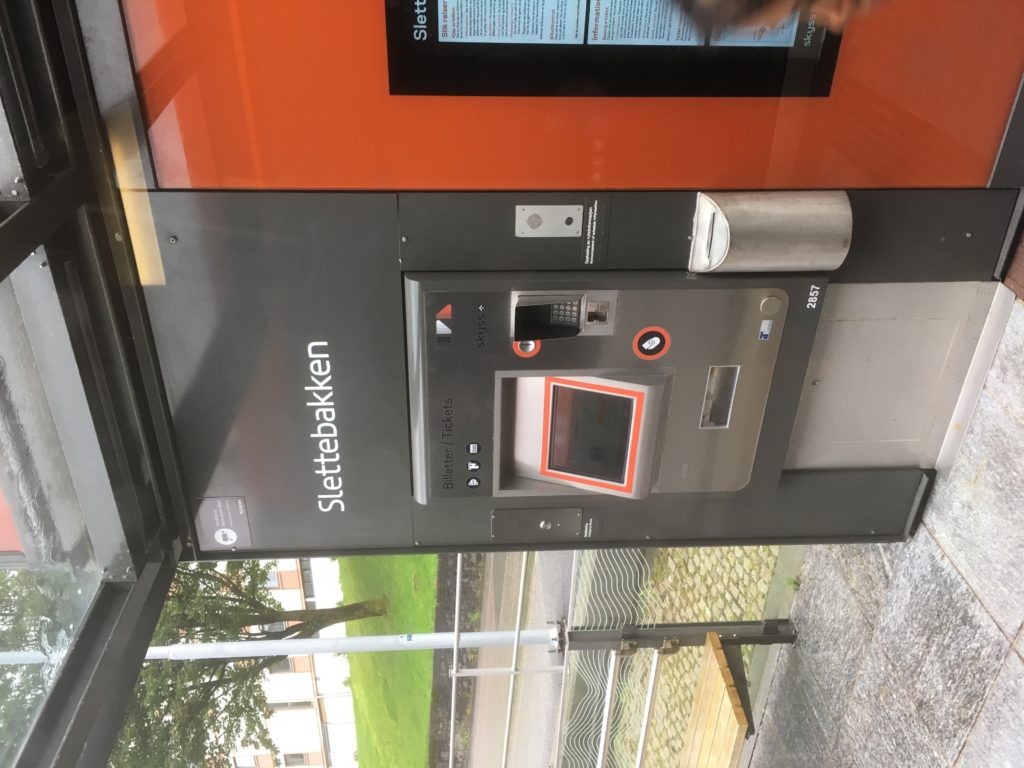 At 16:05 we checked in at the airport. This was the first time (for me) that the process was entirely automatic. It seemed like all check-in counter personnel had been effectively made redundant here. We had some farewell fish at “Fiskeriet”. Behind the cash register hung stockfish, looking like they had been scared to a horrific death and then having their intestines opened.
At 16:05 we checked in at the airport. This was the first time (for me) that the process was entirely automatic. It seemed like all check-in counter personnel had been effectively made redundant here. We had some farewell fish at “Fiskeriet”. Behind the cash register hung stockfish, looking like they had been scared to a horrific death and then having their intestines opened.
At 17:35, flight KL1190 took as back to our native country, where we landed in warmer and sunnier weather around 19:25. It was the first time ever that the Dutch weather we returned to was actually better than at the holiday destination we had come from. Luggage retrieval was ridiculously fast, and in fact both our trolleys came off the carousel first, and together. We hit home at 21:00.
The Atari ST and the Creative People – Volume III
Today was the day on which I received the third and final Volume in the impressive set of tomes dedicated to the history of the Atari ST and the scene around it. Entitled “Return of the Borders”, this one covers 1994 up to 1998. There is a lot of info on the Falcon, the Jaguar, what happened to Atari (and the brand name), and of course various key games and demos that appeared on those various Atari machines. More strikingly than in earlier Volumes, “Return of the Borders” features coverage of many Atari (or Atari-related) conventions that were organised in the book’s time frame.
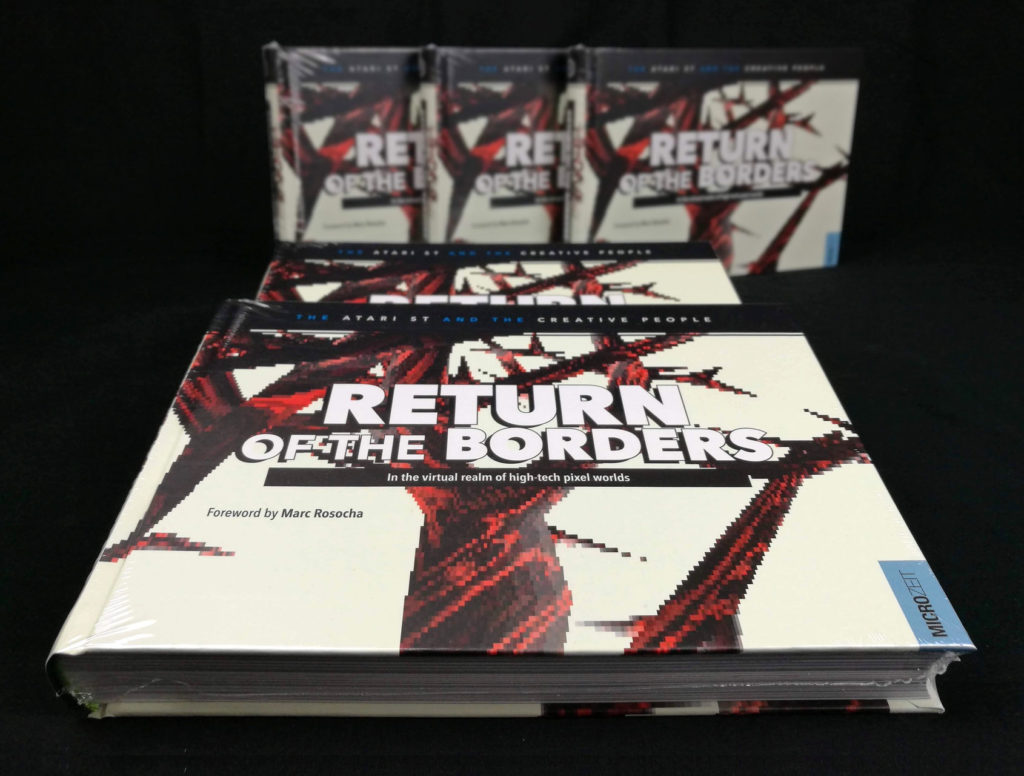 Whereas Volume II filled me with a sense of sadness and perhaps even longing, Volume III allows me to look at the whole experience from rather more of a distance. I was never really part of that era, and every page piques new interest in me. Some truly amazing stuff was happening all over the place, and for the first time did I read about all these demos and conventions that I had only really ever heard of. And there they are, front and centre: the people who did it all. Filled with legendary names like DHS, TSCC, Avena, Reservoir Gods, Lazer and Synergy (including a mention of the legendary Crapman game!), page after page sends me into throes of admiration for what these crews did. And once more this Volume is beautifully illustrated, professionally printed and bound. A book for the ages, like its earlier two brothers.
Whereas Volume II filled me with a sense of sadness and perhaps even longing, Volume III allows me to look at the whole experience from rather more of a distance. I was never really part of that era, and every page piques new interest in me. Some truly amazing stuff was happening all over the place, and for the first time did I read about all these demos and conventions that I had only really ever heard of. And there they are, front and centre: the people who did it all. Filled with legendary names like DHS, TSCC, Avena, Reservoir Gods, Lazer and Synergy (including a mention of the legendary Crapman game!), page after page sends me into throes of admiration for what these crews did. And once more this Volume is beautifully illustrated, professionally printed and bound. A book for the ages, like its earlier two brothers.
I have to admit I was surprised by 3 pages spent on the final issue of ST NEWS, including pics of a variety of bands wielding the “ST NEWS – THE Atari ST Disk Magazine” T-shirt. It conjured up a smile and a tear, which coincides with the overal sensation of the whole “The Atari ST and the Creative People” series.
Awesome. Respect, Marco!
This book, as well as the earlier two Volumes, can be purchased at www.microzeit.com. If you’d like to read my 2018 review of Volumes I and II, check out this page.
One Year without Facebook
Time has flown by since I abandoned Facebook. Today it’s been a year exactly.
And I have to say there are advantages and disadvantages to no longer using Facebook. An obvious advantage is that I have more time on my hands that I would otherwise have thrown away using Facebook – watching memes, viewing videos, trying to keep abreast of things my most casual of friends were doing. FOMO in action. Instead I do use Twitter, but nowhere near consuming as much time as Facebook. A disadvantage is that I am rapidly losing touch with quite a few of my better than casual friends. And, obviously, it is difficult for me to post questions of a technical nature, that would previously have been responded to (and more often than not quite properly and proficiently answered) within a few hours at most.
A few days after the official Facebook your-account-will-now-really-be-deleted deadline I did try to log in. I was relieved to notice it was actually no longer possible, so I therefore had to assume my details were really truly gone. There was a certain degree of ambivalence to my relief though – it was, after all, also a bit like finding out an ex-partner had removed my contact details from her phone ;-).
After a few months not entirely bereft of regret, my feelings of cold turkey slowly wore off. Ever since the end of February, however, I have felt better than ever before. This is due to Troed Sangberg putting me in touch with MeWe.com. This is a fairly new social network that will not mine your data or track you, and in fact one of its advisors is the creator of the World Wide Web, Sir Tim Berners-Lee. I have befriended quite a few people there, especially friends of the, shall we say, technical persuasion. And I don’t post stuff about where I am and what I am eating there – things I used to do on Facebook but for which I kinda hated myself. Although web guru Frederic Poeydomenge has not joined yet, I expect the major disadvantage of being without Facebook to be largely compensated shortly.
Anno 1999
It is 20 years ago that I made my first home page. Back then I think it was on the server of a friend (the late Gard Eggesbo Abrahamsen, may he RIP) and I don’t recall there was a fancy domain name. It may have been something like www.scriba.org/karsmakers.
Of course that page was nothing like the current version. In fact it was a few frames with some basic (and probably useless) info about myself. I guess it was a thing you just did once you took out a subscription with an internet provider. I withstood the temptation to add dozens of animated GIFs like some people did, which may in retrospect have been the only positive thing it had going for it. It gradually grew to include some info about my first marriage (sortof a – censored – honeymoon diary) and some semi-professional information. Then my CV got added, and for a while there was a page advertising myself as your go-to person if you wanted English press releases/lyrics checked. I doubt that particular page was ever found by anyone. The Internet Wayback Machine has an old partial (more like ‘butchered’) copy from circa 2001 and and then again after my first divorce (basically the same as before, minus the “Wedding” menu item).
So today marks a historic event for…um…nobody but me, actually. Twenty years of exhibitionism on the web, culminating into the WordPress site you see before you (from February 2012).
Half a Year without Facebook
And I have to admit I have survived admirably. It’s toughest when I need some technical help and I can’t just post a status message that’d get virtually instant help from one of my very many geek Facebook friends. I have also lost touch with some people that I really felt like being in touch with by just occasionally checking their walls.
But it’s much cooler around birthdays, because I have reverted to sending congratulatory emails and getting an actual response back is much cooler than just getting a “Like!” to my “Congratulations!”. Much more personal.
I strongly doubt that I will be thinking the same when my birthday comes around…

